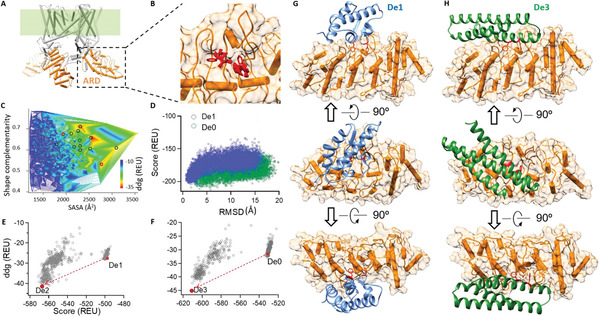Scientists design peptidic positive allosteric modulators targeting TRPV1
With the expeditious development of structural biology techniques represented by single-particle cryo-electron microscopy, the 3D structures of an increasing number of important proteins have been revealed. Taking ion channels as an example, at present, the structure of at least one member of virtually every major ion channel family has been successfully resolved. It is thus one major research direction to promote the development of drugs targeting important proteins by utilizing numerous high-resolution 3D structures.
In collaboration with researchers at UC Davis and Qingdao University, the research team led by Prof. YANG Fan from the Department of Biophysics at the Zhejiang University School of Medicine designed peptidic positive allosteric modulators (PAMs) based on the high-resolution structure of the transient receptor potential vanilloid 1 (TRPV1) ion channel. They exhibit long-lasting in vivo analgesic effects in rats. The research findings are published in an article entitled “De novo design of peptidic positive allosteric modulators targeting TRPV1 with analgesic effects” in the journal Advanced Science.
Severe pain not only drastically lowers the quality of life in patients but also incurs enormous socioeconomic costs. Therefore, there is an urgent need to study the molecular mechanisms of pain and develop safe and effective analgesic drugs. As a prototypical sensor involved in pain sensation, the TRPV1 ion channel is an effective target for analgesic drugs by controlling the flow of ions across cell membranes and converting pain and stimulus signals into neural electrical signals.

Computational design of protein binders to the ARD of TRPV1
The TRPV1 ion channel is closely bound up with nociception. Interestingly, both the agonists and antagonists of TRPV1 can effectively alleviate pain. In recent years, TRPV1 has been regarded as one of the most promising targets for the development of analgesic drugs. However, since the TRPV1 channel is a polymodal receptor activated by heat and involved in body temperature regulation, blockade of this channel may incur substantial hyperthermia in clinical trials, thereby impeding further drug development. Side effects should thus be avoided in the development of analgesic drugs targeting the TRPV1 channel. On the strength of previous studies, researchers designed several positive allosteric modulators to increase the flow of calcium through the TRPV1 channel and reversibly inactivate the TRPV1-expressing nerve terminus, thus exerting analgesic effects.
TRPV1 is a calcium-dependent desensitized channel, and desensitization is closely related to the ankyrin repeat-like domain (ARD) of TRPV1. Researchers first improved the optimized hotspot centric approach (OHCA) protein design strategy to increase the success rate of obtaining robust designed binders. They then applied the improved Rosetta protein design approach to precisely target the ARD of TRPV1 to achieve positive allosteric modulation. Moreover, both the crystal structure of the ARD and the cryo-electron microscopy structures of TRPV1 were determined. With a combination of OHCA design, fluorescence resonance energy transfer (FRET) imaging, protein chemistry, surface plasmon resonance (SPR), patch-clamp recordings, and animal behavioral tests, they revealed that the designed PAMs could positively modulate the TRPV1 channel. Furthermore, they observed noticeable analgesic effects in rats.
The advent of high-resolution 3D structures opens the door to the rational designing of regulatory molecules based on the structure of target proteins, which is more time-saving, less costly, and significantly more successful compared with the conventional large-scale screening. “In this study, we made an attempt to design regulatory molecules targeting specific structural domains, which will provide theoretical support and new ideas for the development of analgesic drugs targeting the TRPV1 channel,” said Yang. “The OHCA computational design strategy can also be widely applied to the development of regulatory molecules for various protein drug targets with known 3D structures.”